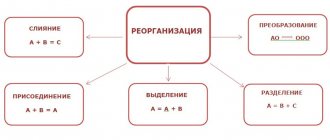The Labor Code of the Russian Federation does not regulate possible reasons for staff reductions, as well as workers. But in order to carry out the procedure, there must be a basis that shows the need to introduce a new staffing table. Reductions can be made due to a crisis or economic feasibility. In all organizations, including budgetary institutions, reductions are considered legal only if there are compelling reasons for excluding a number of positions from the staff list and dismissing employees.
Grounds and reasons
Without a reason, staff reduction is impossible by law, that is, according to the regulations of labor legislation, an employee cannot be laid off without any reason. Reasons for reduction are needed to begin the procedure.
Important! If there is no objective reason, then the employer cannot draw up a reduction plan and fire employees. Despite the absence of a list of reasons and grounds in the Labor Code of the Russian Federation, reduction is impossible, since unjustified dismissal violates the rights of workers. Any reduction without reason is considered unjustified.
It is worth considering that the basis for making a reduction must be drawn up in the form of documents, including memos and certificates. It is on the basis of existing reasons and grounds that a reduction order is created, and the commission develops a procedure plan and a new type of staffing schedule.
Types of bases:
- external reason. Among the external factors that may influence the need for reduction may be the loss of the production base, for example, as a result of natural disasters or a crisis in the industry. Such factors also include a sharp drop in demand for products and various economic reasons associated with the foreign market;
- Internal reasons often include a change of owner, as well as a number of reorganization measures. With any internal optimization of staff, reductions are possible;
- The most common reason for economic downsizing is considered to be a decrease in employee costs as a result of the influence of internal or external factors. For example, demand for products falls, which forces the owner of the organization to reduce and optimize production;
- organizational measures. This type of reduction is considered the simplest option. Jobs with similar job responsibilities are being eliminated. By organizing and reducing a number of positions, the manager receives a more efficient staff;
- technological factor. Often reductions are made after the introduction of automated production lines and other technological innovations. This makes it impractical to maintain a large staff of workers.
Important! The employer is not obliged to transmit data on the reasons for the layoff to organizations and employees, but if there are violations, the labor inspectorate or court may request all documentation on the grounds of the procedure. If the basis was not very objective, then the reduction procedure will be declared invalid, which will lead to its cancellation and the return of employees to their previous jobs.
Not only the employee, but also the trade union organization can apply to the labor inspectorate or judicial authorities to review the objectivity of the reasons and grounds for layoffs. If necessary, it is also possible to file a class action lawsuit against the employer for violations during layoffs and insufficient grounds for layoffs.
Legitimate reasons for layoffs
There are many legitimate reasons that may prompt the director of an organization to begin the downsizing procedure. Among the most popular it is worth highlighting:
- economic instability of the organization or the presence of financial problems that do not allow maintaining the same staff. If a company is experiencing financial difficulties, then the best option would be to downsize. It will preserve the integrity of the entire organization and the ability to continue to function;
- inefficiency of the current staff. This formulation usually implies the presence in the staffing table of positions that duplicate each other or are interchangeable;
- the use of new technologies to replace human labor with machines. This formulation is usually used when automating production, replacing outdated equipment (where human assistance was required) with more advanced equipment, or when introducing new technologies.
It is important to know! Regardless of the justification for the reduction, the head of the organization must be ready, during an inspection by higher authorities, to provide documented evidence of the reasons for the reduction. For example, provide documents about the poor financial condition of the company or confirming the use of new technologies.
To prevent the occurrence of negative aspects and labor disputes, it is recommended that the justification for the reduction be indicated in the order and notification to the employee. These activities make it possible to inform employees of the exact reasons for dismissal. At the same time, an employee who disagrees with the justification for the reduction will not be able to obtain recognition of unlawful actions by the head of the company without providing additional evidence. If, during an inspection by higher authorities, facts are revealed that make it possible to prove the fictitiousness of the measures, for example, the reduction was started only to fire a specific employee, then the directors of the company can be held accountable in court.
Read on topic:Employee’s consent to dismissal due to reduction
Read on topic: Possible reasons for staff reduction
Procedure
Registration of the basis is a preliminary stage before the decision to reduce staff and draw up a new schedule for staff units. Various types of documents can confirm the reason for the need to reduce and optimize staff:
- memorandum from the head of the department or production line;
- financial documents showing a decline in profits or lack of market demand for services or products;
- accounting reports on balance sheet statistics regulating the need to reduce costs.
Important! Relevant documents must be available. It is they who regulate the decision to reduce and the beginning of the development of a reduction plan, which should be a solution to the problem. The reduction order is already issued on the basis of the drawn up reduction plan and the decision on the need to exclude a number of positions from the staff.
The step-by-step reduction process is as follows:
- a reason appears that indicates the need for reduction;
- after providing the necessary documents confirming the existence of the basis, a decision is made on the reduction and a commission is created that develops a plan that will allow the creation of a new staffing table;
- after approval of the reduction plan, an order is issued;
Sample order to reduce the number of employees
- workers and organizations are notified;
- the reduction procedure is carried out according to the established regulations, that is, with the offer of available vacancies and transfers;
- employees are laid off from their positions and receive full pay.
It is worth considering that, regardless of the basis for the layoff, labor rights should not be violated. Beneficiaries and persons with state guarantees cannot be laid off. In a budgetary institution, the procedure is also carried out taking into account all the regulations and articles of the Labor Code of the Russian Federation. The only difference is that the decision on reduction can be made by a regional or any other higher authority. In a private organization, this decision, based on available reasons, is made by the manager, that is, the direct owner.
Read on topic: Retrenchment of a parent of a disabled child
Read on topic: Refusal to offer a position during layoff
The reality of layoffs as a condition for the legality of dismissal
Dismissal of an employee under clause 2, part 1, art. 81 of the Labor Code of the Russian Federation (reduction of staff) will be legal only if a reduction in staff or number (or both) of workers actually took place. Let us explain the concepts of “downsizing” and “staff reduction”:
- The number of employees refers to their payroll composition. As a result of the reduction, the total number of employees working in one position is reduced, although all existing positions remain in place. For example, out of 5 people working as accountants, 2 are laid off.
- Staffing refers to the totality of positions available in an organization. The result of its reduction will be the abolition of entire structural divisions with all positions, or certain positions within one or more divisions. For example, the position of assistant manager was eliminated, so all employees holding such a position are subject to dismissal. At the same time, the number of employees may not change, since the employer can create new positions and divisions.
Not any change in the organizational structure of an enterprise is grounds for dismissal of employees due to reduction, since it may not lead to a reduction in numbers or staff (for example, renaming and moving positions from one division to another). The fact of reduction must be confirmed by making appropriate changes to the staffing table, i.e. it must be clear that staffing units for certain positions or specific positions have been excluded.
Features and judicial practice
Staff reduction can be made for a variety of reasons, but first of all it must be justified.
Important! If the reduction of employees and the positions they occupy was unjustified, then the court may cancel the procedure, either completely or partially. This will depend on the existence of reasonable factors that influenced the employer’s decision to introduce a new staffing table.
In case of any violation of labor rights upon dismissal, an employee can contact various regulatory authorities, for example, the labor inspectorate. Despite the fact that the employer is not obliged to provide data on the decision to lay off, the inspectorate can conduct an inspection. The same option exists if the court has doubts when considering a case about the legitimacy of the procedure. Based on the results of the inspection, a decision will be made to hold the employer accountable, if necessary.
It is worth considering that if the employer only cuts positions without employees, then the basis for staff reduction will not be biased in any case. All controversial issues are related to violation of the labor rights of employees.
Possible reasons for staff reduction may vary in nature, but they are considered the basis for making a decision to reduce a number of staff positions. The main condition for any reduction is the absence of violations of labor legislation, including the proven necessity of the procedure. If the grounds are insufficient, the employer cannot carry out the procedure for laying off employees, since this violates their immediate rights. In this case, the employee who was fired can go to court and be reinstated in his previous position.
Adjustment of staffing
Before starting the reduction procedure, it is necessary to adjust the staffing table. All vacant positions that are not currently needed by the Company should be excluded from the staffing table. It is necessary to do this because, in accordance with Part 3 of Art. 81 of the Labor Code of the Russian Federation, the employer is obliged to offer the laid-off employee all available vacant positions (both a vacant position or job that corresponds to the employee’s qualifications, and a vacant lower-level position or lower-paid job). Therefore, if the employer’s goal is to reduce personnel costs and vacant positions are not needed at the moment, then they need to be removed from the staffing table.
Infertility
Girls who suffer from vaginismus, but do not have problems with hormonal levels and concomitant sexual diseases, may well give birth to children, provided that the sperm enters the vagina. But the presence of sexual intercourse is extremely problematic for such patients; as a result, secondary infertility begins to form. Today, IVF can help, namely the use of a whole range of artificial insemination methods. But first, it is necessary to remove personal and deep-seated psychological problems. A woman with this diagnosis is quite capable of giving birth and bearing a baby, and for most, after giving birth, problems with spasms end.
Responsibilities and guarantees in case of early termination of the contract
When dismissing employees, the employer is obliged to comply not only with the procedure for registering a layoff, but also with some of the rights of his subordinates. What responsibilities does the head of an organization have?
By agreement of the parties
One of the forms of dismissal is by agreement of the parties. In this case, the employer and his employee come to a common agreement regarding dismissal. The procedure for such a reduction is quite simple and has virtually no legal restrictions. Any employee can resign, even if he is on sick leave.
What are the benefits of laying off an employee by mutual agreement with the employer?:
- The parties can independently decide on the procedure and timing of dismissal, as well as the amount of compensation;
- After dismissal, you do not need to “work off” for the period established by law. At the same time, unemployment benefits for those laid off “at their own request” will be higher;
- And finally, an exceptional feature: employees who have a record of layoffs are ranked lower. It is easier to find a new job if the dismissal was by agreement of the parties.
All conditions for dismissal by agreement of the parties are observed based on the law, as well as the executed employment contract.
Being on sick leave
Sick leave is a statutory basis for an employee’s absence from work. The Labor Code of the Russian Federation speaks about this. During this period, the employer does not have the right to dismiss his subordinate . It is possible to lay off an employee who is on sick leave only at his request or in the event of a complete closure of the enterprise.
During alignment
There is a special category of employees who operate in several enterprises at once. Part-time work is a fairly common practice. It is possible to lay off such a subordinate in the same manner as a full-time employee .
Of course, the fired person will have to pay severance pay. In practice, it is not necessary to pay salaries to a laid-off employee during the period of his new employment, since such a person already has a main place of work.
To whom and how are positions offered?
The responsibilities of an employer carrying out staff reduction measures include offering available vacancies to dismissed employees.
What you should pay attention to:
- Vacancies are offered in accordance with the employee’s qualifications, and not all available ones (appeal ruling of the Moscow City Court dated August 30, 2016 in case No. 33-32998/2016).
- A freelance employee, i.e., a worker under a civil contract, is not required to offer other positions when being laid off (ruling of the St. Petersburg City Court dated May 6, 2010 No. 5848).
- Temporarily vacant positions (in particular, in connection with an employee going on maternity leave) are not offered to those who are being laid off (decision of the Moscow City Court dated May 29, 2014 No. 4g/8-3516).
Vacancies are offered in writing, and written consent or refusal to be transferred to another position is obtained from the employee.
For how long will benefits be paid?
The period of compensation directly depends on the working conditions of the company's employees . So:
- For the first month after layoff, cash benefits are provided to all laid-off employees. Pay day is the last day of work in the organization;
- Second month. Payment occurs exactly 60 days after the layoff. Conditions for issuing benefits - if the employee has not yet found a job for the second month in a row at the time of receiving the benefit;
If an employee finds a new job on the 15th day of the second month of unemployment, then compensation is paid only for the period of actual unemployment.
- Third month. The payment occurs if two conditions are met: if the employee has not found a new job and if in the first two weeks after the layoff he joined the labor exchange due to temporary unemployment;
- Subsequent months. Benefits during this period are provided only to the “northern” category of workers. Those. those employees who worked in difficult climatic conditions. Temporary unemployment from the third to sixth months is compensated by the labor exchange;











